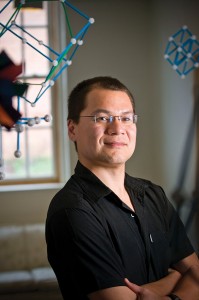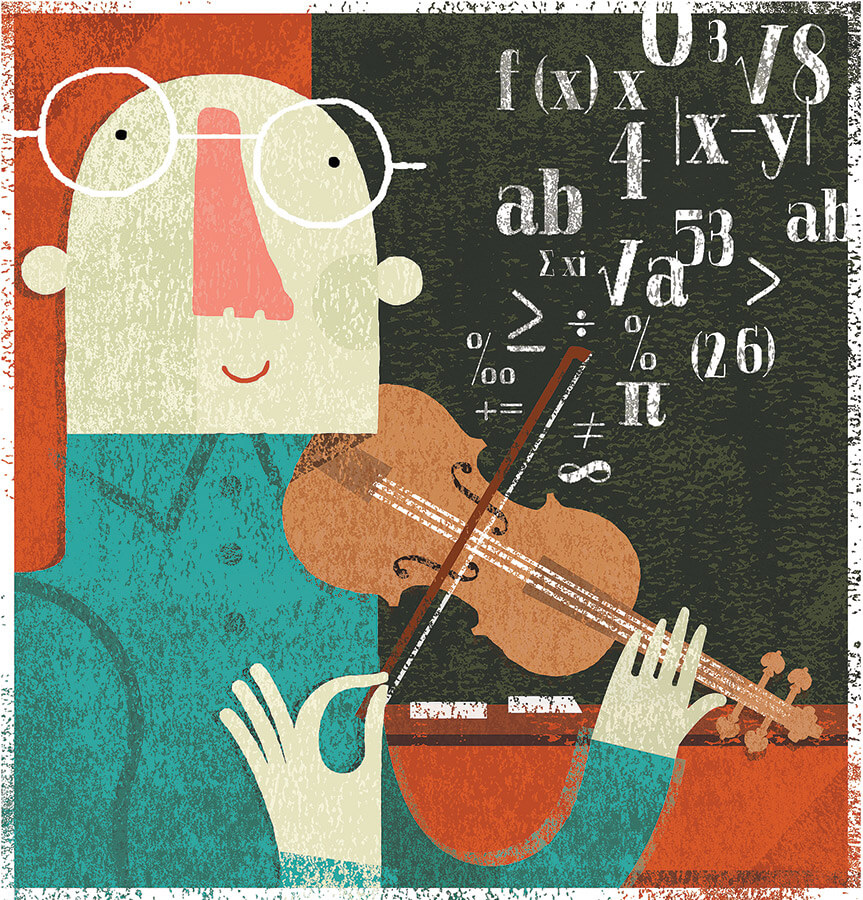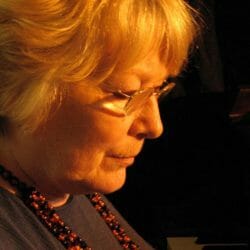Musical Numbers
David Kung delves into the weird and wacky world of the connections between math and music — while factoring social justice into the equation.
Here are some fun facts for your next dinner party: all voices on cell phones should sound female.
A piano can never be perfectly in tune. It is possible to play “Taps” simply by swinging a piece of pool tubing in a circle over your head.
David Kung ’94, MA’96, PhD’00 is full of these types of odd statements, and he can explain the math behind all of them. Kung is a professor at St. Mary’s College of Maryland, where he teaches Math, Music, and the Mind, and he speaks around the world about the connections between math and music. Based on a lecture he gave in California, he was recruited by an organization called The Teaching Company to create a class about these relationships.
Both math and music fascinated Kung from a young age. Trained in the violin since he was four, he realized as a teenager that he had to make a career choice.
“When I would talk to musicians who were mid-career,” he says, “they had sort of burned out a little bit on music.” When he talked to mathematicians, however, he found that their passion remained. Coupled with the fact that math seemed the more practical choice, he decided to make it his career, with music as a hobby, little suspecting that he would find a way to combine both in his professional life.
“To me, the real gems of education aren’t in any one of the silos that we put academia in,” he says. “To me, the really interesting parts are in the spaces in between where different subjects connect — the interdisciplinary spaces.”
Kung often plays his violin in Math, Music, and the Mind to illustrate mathematical principles. To keep his students engaged, he uses stunts such as putting PVC pipe in a jug of water and playing a scale by moving the pipe up and down, thus demonstrating the concept of relative frequencies. Kung, who has received numerous teaching awards, requires his students to invent an instrument that uses math principles (the “Wonder Pipe 4000” that he dunked in water was one of them). At the end of the semester, he has students present a concert and incorporate math components into their musical performances.
Kung adapted his St. Mary’s course for The Teaching Company’s Great Courses, which are offered in the form of DVDs, audiotapes, online streaming, and other formats. He gets emails from people all over the world who have taken his class.
“It’s a real privilege,” he says, noting that he’s delighted that he can reach far more people than he would during a lifetime of teaching in a St. Mary’s classroom. While serving as a visiting scholar at Lingnan University in Hong Kong this past semester, he also created another class for The Teaching Company on “mind-bending mathematical paradoxes.”
Music Is Nothing but Unconscious Arithmetic[1]
Mathematics is about understanding patterns, Kung says — which is also true for music. Think of 4/4 time and half steps, twelve-note scales, and series of beats and measures. “Humans come hardwired for both math and music,” he says in his Great Courses series. “Practically from birth, babies start thinking mathematically and musically. Subitizing is instantly counting without counting out each item. Infants subitize at three or four days old.”
Math is also closely involved in the delivery of music in digital forms. Kung can explain coding in detail, but suffice it to say that 1.4 million zeros and ones are transferred from a CD for each second of music. Coding can detect and fix errors introduced during the manufacturing process. Similarly, auto-tuning programs can correct errors; even during a live concert, if a performer sings out of tune, the sound can be corrected between the time when his or her voice enters the microphone and when it comes out of the speakers.
Kung also delves into more hidden ways that mathematical structures underlie music. Why can a piano never be perfectly in tune? Blame the relationship between the two ingredients needed to construct a scale — octaves (any two piano keys twelve apart from each other) and fifths (two keys that are seven apart).
“On a piano, you either have your fifths in tune, or your octaves in tune, but you can’t have both,” Kung explains in his Great Course. “It doesn’t work out mathematically.”
Modern piano tuning uses a technique called equal-tempered tuning to get around that problem by adjusting the intervals between notes slightly to make them come out evenly among all the fifths. “Now, tuning is done so that every key is out of tune to the same degree as every other key,” Kung says. “While the differences are small, this mathematics helps explain the change in composition styles from Bach’s time to modern twentieth-century music.”
Kung also has the inside scoop on cell phones. The speaker inside a phone’s handset can’t produce frequencies below 350 Hz. Women’s voices are typically above that threshold, but men’s voices tend to be around 100 Hz, Kung says. However, vocal cords vibrate at a particular sequence of what are called overtones, so a man’s voice also vibrates at 200 Hz, 300 Hz, 400 Hz, 500 Hz, and on up to your hearing threshold. “Your brain is essentially an incredibly powerful pattern-matching computer,” Kung says. So even though the sounds you hear don’t perfectly fit the pattern of a male voice, your brain fills in the missing lower overtones and registers the voice as male.
When you are talking on a cell phone or listening to other sounds, your ear is performing a Fourier transform, the mathematical name for a principle governing how sound waves are broken down. The Fourier transform breaks sound waves into sine waves of different frequencies, and the human ear actually performs a version of this complicated math when your inner ear decomposes the waves back into single frequencies. “The fact that your ear evolved to do that is stunning,” Kung says. “Because your body does that, your mind can distinguish an oboe playing A from a violin playing A.”
Math-Crazy Composers

David Kung finds surprising connections in his chosen field and beyond. For instance, the Fibonacci sequence (a specific pattern of numbers) is not only integral to musical scales, but also to natural objects such as pine cones, flower petals, and snail shells. Courtesy of St. Mary’s College Of Maryland.
In his classes, Kung doesn’t just rely on musical oddities. He often draws on history to highlight how composers have used math through the ages. Mozart’s Dice Game allowed musicians to create
algorithmic waltzes using pre-composedmusical elements. Players could roll dice and choose specific measures based on the number rolled, resulting in a new piece each time.
Modern composers are even more fond of using math to shape their works. Arnold Schoenberg, a twentieth-century Austrian composer, wanted to create atonal music, with no one note more important than the others, so he turned to math to provide the structure of his pieces. For instance, in every group of twelve notes, he used each note only once, meaning that he would repeat each note the same number of times in a composition, resulting in a very cerebral form of music.
John Cage, an American avant-garde composer, wrote Organ ASLSP (which stands for as slow as possible). “One performance of Organ ASLSP began in 2001, and it’s scheduled to end in 2640,” Kung says. Cage also created a composition with no notes that is written in three movements that add up to four minutes and thirty-three seconds. Kung performed it in 2011, standing motionless with his bow held to his violin in complete silence.
“I see Cage’s 4:33 as an audible form of the number zero,” Kung says. “It took enormous creativity and insight for the Babylonians and Mayans to invent something to stand for nothing [the concept of zero]. Cage’s work is a musical version of the same idea, with a similarly powerful effect.”
Cage also stretched the idea of randomness, Kung says. He composed music based on responses from the I Ching, star charts, rock formations, and more. Charles Dodge composed Earth’s Magnetic Field, in which the pitch changes were taken from the changes due to solar wind in the earth’s magnetic field. Other modern composers such as David Cope use computers and complex algorithms to create their works.
The Most Important Connection
If Kung is passionate about helping people understand the connections between his two favorite fields, he’s just as fervent about making math more accessible to students from disadvantaged backgrounds.
He grew up in Stevens Point, Wisconsin, the child of a math professor father who emigrated from China and a mother who was a musician of Danish heritage. His parents imbued him with a deep sense of justice, which was reinforced during ten years of earning degrees at UW–Madison. “It’s hard to find ways [that the campus] didn’t shape me,” he says. “I was there from age eighteen to twenty-eight — those are pretty formative years.” (Brother Tim Kung MA’96 shares his Badger roots.)
Kung regrets that he wasn’t able to stay in Madison longer, and he says that every May, he wishes he could go running in the Arboretum and smell the lilacs.
As a freshman in 1991, Kung demonstrated against the war in Iraq, and as a graduate student, he was a steward for the Teaching Assistants’ Association, serving on its collective-bargaining team. “I sort of got my activism fix through them,” he says.
But it was another opportunity that had the strongest influence on him. He was recruited to help start the Wisconsin Emerging Scholars program, designed to retain underrepresented students. “That program opened my eyes to the possibility of leveling the playing field for students, and what we can do,” says Kung, who tutored students in calculus. The experience motivated him to orient his career less toward research and more toward teaching so that he could continue to work with issues of inclusion.
Kung started an emerging-scholars program at St. Mary’s, and he’s aiding similar efforts at institutions around the country. He’s observed students who thought they weren’t good at math blossom with talent. “Watching these kids really flourish is incredibly rewarding,” he says.
He also teaches Math for Social Justice, a course that seeks to improve math literacy and responsible citizenship by having students work on real-life problems. One student, he says, was disappointed that fair-trade coffee was not available on campus, so he learned the math concepts behind taking random samples to see if others felt the same way, “and now all our coffee [sold on campus] is fair trade.”
Kung’s passion for social justice extends beyond the classroom. He’s involved in an effort to cap administrator salaries at St. Mary’s at ten times higher than the lowest-paid employee — an initiative that has garnered national media attention.
This summer, Kung will become director of the Mathematical Association of America’s Project NExT (New Experiences in Teaching), a professional-development program for new math faculty. He’s written numerous articles on topics in harmonic analysis and mathematics education, and he’s currently working on a book, What Could They Possibly Be Thinking? Understanding Your College Math Students. Along with his professional duties, he makes time to run twenty miles a week, and spends time with his wife and two children.
“I’ve been fortunate to have a very good life so far,” Kung says. But if anything worries him, it’s that “in the end, the world will not be a better place because I’ve been in it.”
To Kung, a better place doesn’t just mean less poverty and more opportunity, “but a better place could be more people understanding more things. That’s sort of a fundamental philosophy-of-life issue that really cuts to what a liberal arts education is,” he says. “To understand the world around you is a beneficial thing, and I think it’s a beneficial thing in and of itself. You don’t have to have application for it in order for it to benefit you as a person.”
Niki Denison is co-editor of On Wisconsin.
[1] Gottfried Leibniz (German mathematician and philosopher, 1646–1716): “The pleasure we obtain from music comes from counting, but counting unconsciously. Music is nothing but unconscious arithmetic.”
Published in the Summer 2014 issue



Comments
Jim Papandrea June 13, 2014
Fascinating article – as a musician, I’ve always believed that music is a form of math – and math is also an art form. Music is math, and time, and physics. Incidentally, I just finished reading a novel that combines music and time travel (it’s called Time Signature, by fellow Wisconsinite Carlo Kennedy, and I highly recommend it).
Jonathan Rappaport June 17, 2014
As someone who has promoted the arts for the past 45 years (and a professional musician), this is a refreshing confirmation on what research has shown us–amazing connections between the various arts and other academic disciplines. Thank you for this wonderful article, which I will promote in our next newsletter.
Jonathan Rappaport
Executive Director
Arts|Learning, Massachusetts